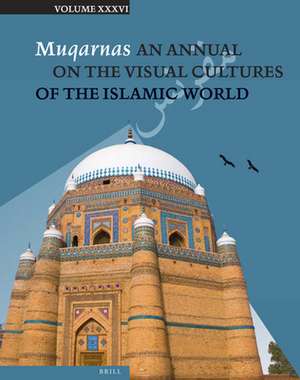Muqarnas 36: Muqarnas, cartea 36
Editat de Gülru Necipoğlu, Maria J. Metzleren Limba Engleză Hardback – 25 noi 2019
The volume begins with an overview by Finbarr Barry Flood of the architecture, calligraphy, epigraphy, painting, and portable arts of pre-Mughal Islamicate South Asia. Pre-Mughal court culture has always played second fiddle to the overwhelming hegemony and brilliance of the Mughal dynasty but in its regional heterogeneity it is more than worthy of study. This is followed by two essays examining manuscript illumination: Cailah Jackson, 2017 winner of the Margaret B. Ševčenko Prize in Islamic Art and Culture, discusses two manuscripts illuminated by Mukhlis ibn ʿAbdallah al-Hindi in thirteenth-century Konya; and Denise-Marie Teece treats the early sixteenth-century Safīna manuscript (Biblioteca Reale Ms. Or. 101), its illuminator Ruzbehan al-Modhahheb, and its unique six-page preface. A Byzantine stole with embroidered Arabic inscriptions in the collection of Vatopediou Monastery on Mount Athos is the subject of the fourth essay by Nikolaos Vryzidis. The volume’s seven essays conclude with three investigations into Ottoman art history: the blue-and-white tiles of the Baba Naqqaş style of the late fifteenth and early sixteenth centuries, as prominently displayed in the Muradiye Mosque in Edirne (Patricia Blessing), the architectural book Risāle-i Miʿmāriyye of the seventeenth-century Caʿfer Efendi and in particular his notes on surveying and the architect’s cubit (Gül Kale), and the evolution of the late sixteenth-century Ottoman custom of requiring the sultan to be victorious over the non-Muslim enemy and to only use spoils from the holy war in the construction of a sultanic mosque (Samet Budak).
The Notes and Sources section continues with Bill Hickman’s analysis of the tantalizing calligraphed tiles of the now destroyed mosque built for the Sufi shaykh and poet Eşrefoğlu Rumi (d. 1469?), and two communications about artifacts on British soil: a wooden box, believed to have contained the heart of Abbot Roger de Norton (d. 1291), with an Arabic inscription that is now deciphered by Barry Knight, 147 years after its discovery; and a gorgeous Persian luster bowl in Oxford’s Ashmolean Museum, which when subjected to UV examination, revealed that it was a product of extensive repair, or “restoration,” over the centuries. A systematic examination of the bowl and its remarkable history by Francesca Leoni and her colleagues uncovers a level of fakery of antiques that, it is suggested, might be prevalent in museum ceramic collections.
Din seria Muqarnas
-
 Preț: 400.96 lei
Preț: 400.96 lei -
 Preț: 325.03 lei
Preț: 325.03 lei -
 Preț: 325.03 lei
Preț: 325.03 lei -
 Preț: 325.03 lei
Preț: 325.03 lei -
 Preț: 325.03 lei
Preț: 325.03 lei -
 Preț: 325.03 lei
Preț: 325.03 lei -
 Preț: 328.34 lei
Preț: 328.34 lei -
 Preț: 380.79 lei
Preț: 380.79 lei -
 Preț: 325.03 lei
Preț: 325.03 lei -
 Preț: 383.63 lei
Preț: 383.63 lei -
 Preț: 325.03 lei
Preț: 325.03 lei -
 Preț: 382.32 lei
Preț: 382.32 lei -
 Preț: 325.03 lei
Preț: 325.03 lei -
 Preț: 385.25 lei
Preț: 385.25 lei -
 Preț: 325.03 lei
Preț: 325.03 lei -
 Preț: 325.03 lei
Preț: 325.03 lei -
 Preț: 325.03 lei
Preț: 325.03 lei -
 Preț: 325.03 lei
Preț: 325.03 lei -
 Preț: 388.57 lei
Preț: 388.57 lei -
 Preț: 325.03 lei
Preț: 325.03 lei -
 Preț: 325.03 lei
Preț: 325.03 lei -
 Preț: 376.40 lei
Preț: 376.40 lei -
 Preț: 325.03 lei
Preț: 325.03 lei -
 Preț: 378.72 lei
Preț: 378.72 lei -
 Preț: 325.03 lei
Preț: 325.03 lei -
 Preț: 411.35 lei
Preț: 411.35 lei -
 Preț: 325.03 lei
Preț: 325.03 lei -
 Preț: 340.12 lei
Preț: 340.12 lei -
 Preț: 375.39 lei
Preț: 375.39 lei -
 Preț: 343.11 lei
Preț: 343.11 lei -
 Preț: 410.93 lei
Preț: 410.93 lei -
 Preț: 413.06 lei
Preț: 413.06 lei -
 Preț: 419.70 lei
Preț: 419.70 lei -
 Preț: 406.53 lei
Preț: 406.53 lei -
 Preț: 415.41 lei
Preț: 415.41 lei -
 Preț: 414.48 lei
Preț: 414.48 lei -
 Preț: 650.95 lei
Preț: 650.95 lei -
 Preț: 377.77 lei
Preț: 377.77 lei -
 Preț: 325.03 lei
Preț: 325.03 lei -
 Preț: 329.20 lei
Preț: 329.20 lei -
 Preț: 326.35 lei
Preț: 326.35 lei
Preț: 408.31 lei
Nou
Puncte Express: 612
Preț estimativ în valută:
78.14€ • 84.85$ • 65.64£
78.14€ • 84.85$ • 65.64£
Carte indisponibilă temporar
Doresc să fiu notificat când acest titlu va fi disponibil:
Se trimite...
Preluare comenzi: 021 569.72.76
Specificații
ISBN-13: 9789004419452
ISBN-10: 9004419454
Dimensiuni: 210 x 270 mm
Greutate: 1.11 kg
Editura: Brill
Colecția Brill
Seria Muqarnas
ISBN-10: 9004419454
Dimensiuni: 210 x 270 mm
Greutate: 1.11 kg
Editura: Brill
Colecția Brill
Seria Muqarnas
Cuprins
CONTENTSFinbarr Barry Flood, Before the Mughals: Material Culture of Sultanate North IndiaCailah Jackson, The Illuminations of Mukhlis ibn ʿAbdullah al-Hindi: Identifying Manuscripts from Late Medieval KonyaDenise-Marie Teece, “Compassionate Companion, Familiar Friend”: The Turin Safīna (Biblioteca Reale Ms. Or. 101) and Its SignificanceNikolaos Vryzidis, The “Arabic Stole” of Vatopediou Monastery: Traces of Islamic Material Culture in Late ByzantiumPatricia Blessing, The Blue-and-White Tiles of the Muradiye in Edirne: Architectural Decoration between Tabriz, Damascus, and CairoGül Kale, Intersections between the Architect’s Cubit, the Science of Surveying, and Social Practices in Caʿfer Efendi’s Seventeenth-Century Book on Ottoman ArchitectureSamet Budak, “The Temple of the Incredulous”: Ottoman Sultanic Mosques and the Principle of LegalityNOTES AND SOURCESBill Hickman, A Forgotten Fifteenth-Century Ottoman Mosque and Its InscriptionsBarry Knight, The Heart Case of Abbot Roger de Norton from St. Albans Abbey: An Islamic Object in a Medieval English ContextFrancesca Leoni, Dana Norris, Kelly Domoney, Moujan Matin, and Andrew Shortland, “The Illusion of an Authentic Experience”: A Luster Bowl in the Ashmolean Museum
Notă biografică
Gülru Necipoğlu, (Ph.D., Harvard University, 1986) is the Aga Khan Professor of Islamic Art and Architecture at Harvard University. She has been the editor of Muqarnas since 1993.
